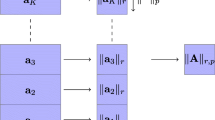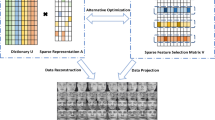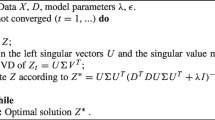Abstract
In recent years dictionary learning has become a favorite sparse feature extraction technique. Dictionary learning represents each data as a sparse combination of atoms (columns) of the dictionary matrix. Usually, the input data is contaminated by errors that affect the quality of the obtained dictionary and so sparse features. This effect is especially critical in applications with high dimensional data such as gene expression data. Therefore, some robust dictionary learning methods have investigated. In this study, we proposed a novel robust dictionary learning algorithm, based on the total least squares, that could consider the inexactness of data in modeling. We confirm that standard and some robust dictionary learning models are the particular cases of our proposed model. Also, the results on various data indicate that our method performs better than other dictionary learning methods on high dimensional data.


Similar content being viewed by others
References
Aharon M, Elad M, Bruckstein A (2006) K-SVD: an algorithm for designing overcomplete dictionaries for sparse representations. IEEE Trans Signal Process 54(11):4311–4322
Alon U et al (1999) Broad patterns of gene expression revealed by clustering of tumor and normal colon tissues probed by oligonucleotide arrays. PNAS 96(12):6745–6750
Bishop C (2006) Pattern recognition and machine learning. Springer, Berlin
Bjorck A (2015) Numerical methods in matrix computations. Springer, Berlin
Chang H, Yang M, Yang J (2016) Learning a structure adaptive dictionary for sparse representation based classification. Neurocomputing 190:124–131
Chen C, Huang J, He L, Li H (2014) Fast Iteratively reweighted least squares algorithms for analysis-based sparsity
Elad M (2010) Sparse and redundant representations: from theory to applications in signal and image processing. Springer, New York
Engan K, Aase S, Husoy J (2000) Multi-frame compression: Theory and design. Signal Process 80:2121–2140
Fan Z, Ni M, Zhu Q, Liu E (2015) Weighted sparse representation for face recognition. Neurocomputing 151:304–309
Feiz R, Rezghi M (2017) A splitting method for total least square color image restoration problem. J Vis Commun Image Represent 46:48–57
Fu H, Ng MK, Barlow JL (2006) Structured total least squares for color image restoration. SIAM J Matrix Anal Appl 28:1100–1119
Golub TR et al (1999) Molecular classification of cancer: class discovery and class prediction by gene expression monitoring. Science 286(15):531–537
Golub GH, Van Loan C (2013) Matrix computations, 4th edn. The Johns Hopkins University Press, Baltimore, pp 320–327
Khademlou M, Rezghi M (2015) Integrated single image super resolution based on sparse representation, AISP
Khan J et al (2001) Classification and diagnostic prediction of cancers using gene expression profiling and artificial neural networks. Nat Med 7(6):673–679
Kim H, Park H (2007) Sparse non-negative matrix factorizations via alternating non-negativity-constrained least squares for microarray data analysis. Bioinformatics 23:1495–1502
Kukush A, Tsaregorodtsev Y (2016) Asymptotic normality of total least squares estimator in a multivariate errors-in-variables model AX=B. Modern Stochast Theory Appl 3:47–57
Kunchevaa LI, Rodríguez JJ (2018) On feature selection protocols for very low-sample-size data. Pattern Recognit 81:660–673
Lai M, Xu Y, Yin W (2013) Improved iteratively reweighted least squares for unconstrained smoothed \(l_{q}\) minimization. SIAM J Numer Anal 51:927–957
Lee G, Barlow Jesse L (2017) Two projection methods for regularized total least squares approximation, Linear Algebra Appl 461:18–41
Li Y, Ngom A (2013) Non-negative least squares methods for the classification of high dimensional biological data. IEEE/ACM Trans Comput Biol Bioinform 10:447–456
Li Y, Ngom A (2013) Sparse representation approaches for the classification of high-dimensional biological data. BMC Syst Biol 7:S6
Liao L, Li Q (2016) Parameter identification and temperature compensation of quartz flexible accelerometer based on total least squares. Int J Signal Process Syst 4(1):27–31
Liu M, Zhang D (2016) Pairewise constraint-guided sparse learning for feature selection. IEEE Trans Cybern 46:298–310
Luh K, Vu V (2016) Dictionary learning with few samples and matrix concentration. IEEE Trans Inform Theory 62(3):1516–1527
Mukherjee S, Basu R, Seelamantula CS (2016) \(l_{1}\)KSVD: a robust dictionary learning algorithm with simultanous update. Signal Process 123:42–52
Notterman DA et al (2001) Transactional gene expression profiles of colorectal adenoma, adenocarcinoma, and normal tissue examined by oligonucleotide arrays. Cancer Res 61:3124–3130
Piage CC, Suanders MA (1982) LSQR: an algorithm for sparse linear equations and sparse least squares. ACM Trans Math Softw 8:43–71
Piao Y, Piao M, Park K, Ryu KH (2012) An ensemble correlation-based gene selection algorithm for cancer classification with gene expression data. Bioinformatics 28:3306–3315
Rezghi M, Hosseini SM, Elden L (2014) Best Kronecker product approximation of the blurring operator in three dimensional image restoration problems. SIMAX 35:1086–1104
Rosen JB, Park H, Glick J (1996) Total least norm formulation and solution for structured problems. SIAM J Matrix Anal Appl 17:110–126
Sadeghi M, Babaie-Zadeh M, Jutten C (2013) Dictionary learning for sparse representation: a novel approach. IEEE Signal Process Lett 20(12):1195–1198
Sadeghi M, Babaie-Zadeh M, Jutten C (2014) Learning overcomplete dictionaries based on atom-by-atom updating. IEEE Trans Signal Process 62(4):883–891
Sigl J (2016) Nonlinear residual minimization by iteratively reweighted least squares. Comput Optim Appl 64:755–792
Yang J, Wright J, Huang TS (2010) Image super-resolution via sparse representation. IEEE Trans Image Process 19:2861–2873
Yin X, Xu Y, Shen H (2016) Enhancing the prediction of transmembrane \(\beta -\)barrel segments with chain learning and feature sparse representation. IEEE/ACM Trans Comput Biol Bioinform 13:1016–1026
Yu Q, Dai W, Cvetkovic Z (2019) and Jubo Zhu Dictionary. Learning with BLOTLESS Update, Arxive
Zhai Y, Yang Z, Liao Z, Wright J, Ma Yi (2019) Complete dictionary learning via \(l_4\)-norm maximization over the orthogonal Group, Arxiv
Zhanga S, Zhang C, Wanga Z, Kong W (2018) Combining sparse representation and singular value decomposition for plant recognition. Appli Soft Comput 67:164–171
Author information
Authors and Affiliations
Corresponding author
Additional information
Publisher's Note
Springer Nature remains neutral with regard to jurisdictional claims in published maps and institutional affiliations.
Rights and permissions
About this article
Cite this article
Parvasideh, P., Rezghi, M. A novel dictionary learning method based on total least squares approach with application in high dimensional biological data. Adv Data Anal Classif 15, 575–597 (2021). https://doi.org/10.1007/s11634-020-00417-4
Received:
Revised:
Accepted:
Published:
Issue Date:
DOI: https://doi.org/10.1007/s11634-020-00417-4




